
Published by the Fleet Air Arm Association of Australia Inc Print Post Approved PP100002097 MARCH 2024 VOLUME 35 NO 1 HMAS STUART FLIGHT APRIL 2004 OPERATION CATALYST PERSIAN GULF

ACTING NATIONAL PRESIDENT
Phil Carey
NATIONAL SECRETARY & EDITOR
Terry Hetherington
PO Box 7115, Naval PO, Nowra Hill NSW 2540
Email:slipstream@theFAAAA.com
WEBMASTER
Marcus Peake
Email:webmaster@theFAAAA.com
ACT
President
Bruce Tunnah
Secretary
George Sydney
NEW SOUTH WALES
President
Phil Carey
Secretary
Dick Martin
QUEENSLAND
President
StephenHuxtable
Secretary
Stephen Huxtable
SOUTH
President
John Siebert
Secretary
Roger Harrison
TASMANIA
President
Michael Kus
Secretary
Graham Nicholas
VICTORIA
President
Chris Fealy
Secretary
Malcolm Smith
WESTERN
President
Mike Keogh
Secretary
Mick Spahn

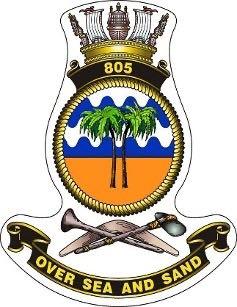



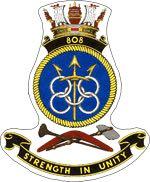


INTHISISSUE


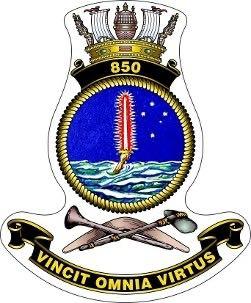

2
AUSTRALIA
AUSTRALIA
3 THE EDITOR’S PIECE 4 SENIOR DEFENCE APPOINTMENTS 5 OPEN LETTER TO ALL MEMBERS 6-15 NEWS FROM THE FAAAA DIVISIONS 16-17 RANHFV UPDATES 18-19 HMAS VOYAGER — COMMEMORATING 60 YEARS 20 IN MEMORY OF REAR ADMIRAL GUY GRIFFITHS 21 ‘GHOST SHARK’ IS LAUNCHED 22-23 SEA FURIES vs MiG’s OVER KOREA 24-27 ‘STRINGBAG’ or ‘SWORDFISH’ WHAT’S IN A NAME? 28 AVIATORS’ HUMOUR 29 VC’s FOR MIDSHIPMEN AT GALLIPOLI 30 ONE-on-ONE A-4 vs F-18 31 THE CRADLE OF AUSTRALIAN MILITARY AVIATION 33 IN MEMORIAM

THE EDITOR’S PIECE
Terry Hetherington—National Secretary / Editor.
The production of this edition of ‘Slipstream’ has overrun the deadline and I apologise to all our readers for the late delivery. A significant activity of the National Executive has been the follow up from a letter to CN (Page 32) concerning the Fleet Air Arm Museum. The Director of the Sea Power Centre, CAPT Alastair Cooper RAN met with Association representatives in March; and although some assurances were received, the matter is still to be resolved.
The letter I wrote to all Divisions is reproduced on Page 5, and it is an appeal to the entire membership of the Association to step up and offer your service and commitment to the Association. We are looking for new and more youthful talent to assume positions on the National Executive. Can you help?
I trust that readers will enjoy the spread of news and historical articles in this issue. Submissions from the Divisions are always greatly appreciated and relevant stories from near and far have been in abundance. Some will be carried over until the next edition. I want to single out ex-WOATA Fred Campbell OAM, who, as the result of a recent casual chat, inspired the cover story on Seahawk 872 and LACM Ben Sime.
Death and taxes are unavoidable; however the passing of long-standing colleagues reminds one of their inevitable end. I refer to Greg Wise, George Mackenzie, RADM Guy Griffiths, Keith Doncon and Peter Ruhl - all people with whom I have had connections and great respect for their talents.
Lest We Forget.
COVER STORY AN ANZAC DAY TO REMEMBER, 20 YEARS ON.
On 24 April 2004, Leading Aircrewman Ben Sime was serving as a sensor operator on Seahawk 872, callsign ‘Christine’, in the Persian Gulf. The helicopter was operating off HMAS Stuart when terrorists in fishing dhows launched a series of attacks against Iraqi oil terminals. One of these dhows, packed with explosives, detonated when a boat from USS Firebolt drew alongside to investigate. Three American sailors were killed and four were seriously wounded in the explosion.
Following several unsuccessful attempts to rescue survivors, Sime leapt from the aircraft in his flying gear to help a badly wounded sailor.
“He had a severe head laceration and was struggling to stay afloat,” Sime said. “He actually let go of the rescue strop at this point and then lay face down in the water and it was evident he was unconscious.
“At that point I jumped from the aircraft to try and render assistance, turned him over the best I could and tried to render some sort of first aid in the water. At this point in time, it was night so it was a little bit challenging. At the end of the day all I could do at this point was just support him as best I could and keep his head out of the water.
“We managed to get the casualty onto Firebolt and that’s where we continued to try and do CPR. It was pretty chaotic at that point, there were bodies being recovered from the
water and there were a lot of people in distress clearly and it was very hectic.”
During the incident, two further attacks were launched against oil terminals to the south. Sime continued to help the American sailors and was later awarded the Medal for Gallantry in recognition of his bravery.
“We all worked together extremely well as a crew, and we just went about doing what we had to do. In all truthfulness, no, I wasn’t scared, it was just one of those circumstances where you just do what you have to do and worry about it later.”
Sime managed to get the injured sailor to the patrol boat, then to a doctor on HMAS Stuart, but the sailor later died.

“In later years obviously, you still think about it,” Sime said. “It happened on the 24th and it went over into the 25th, so obviously being Anzac Day, every year when Anzac Day comes around for us, and for me personally, it just has my own personal spin on what it means for me.”
3
BEN SIME and ‘CHRISTINE’
Appointment of Australian Defence Force senior leadership, and Navy’s first CDF in 21 years
9 APRIL 2024
The Australian Government is pleased to recommend to His Excellency, the Governor-General, a number of senior command changes within the Australian Defence Force (ADF). Subject to the Governor-General’s consideration and approval, the changes will take effect in July 2024.
The Vice Chief of the Defence Force, Vice Admiral David Johnston, AC, RAN will be appointed as the new Chief of the Defence Force. Vice Admiral Johnston joined the ADF in 1978 and has demonstrated outstanding leadership as the Vice Chief of the Defence Force since 2018. His experience in command and the strategic design of the integrated force will be critical to embedding the outcomes of the Defence Strategic Review.
The Government extends its deepest gratitude and thanks to retiring Chief of the Defence Force, General Angus Campbell AO, DSC. General Campbell joined the ADF in January 1981 and has had a distinguished career, leading the nation through regional and global security challenges. He has been at the forefront of driving organisational and cultural change to enhance the ADF as a modern, highly capable, integrated force centred on its people and Defence values.
Air Marshal Robert Chipman, AO, CSC, will be appointed as the new Vice Chief of the Defence Force. Appointed as the Chief of Air Force in July 2022, Air Marshal Chipman has provided excellent and considered leadership of the Royal Australian Air Force over the past two years.
Following confirmation of the Federal Executive Council of the preceding statutory appointments by the Governor General, other senior ADF appointments will also change in early July 2024. The Chief of the Defence Force, in consultation with the Secretary of Defence, Mr Greg Moriarty, AO, and ADF chiefs has recommended to the Deputy Prime Minister and Minister for Defence, several senior appointments, including Rear Admiral Justin Jones, CSC. He will replace Lieutenant General Greg Bilton, AO, CSC, as the Chief of Joint Operations. Rear Admiral Jones is currently the Deputy Chief of Joint Operations.

4

14th April 2024
FAAAA Division Presidents
FAAAA Division Secretaries
Dear FAAAA Colleagues,
The purpose of this letter is to bring to the attention of your Division how the lack of volunteers is impacting on the National Executive (NE), and the consequences if this situation cannot be resolved.
Over the past year there have been a number of advertisements in our periodicals asking for volunteers for the positions of National President, Slipstream Editor and Webmaster. Regrettably, none have been found but the NE has managed to function, nonetheless.
We do not believe this is a sustainable situation. We have been without a National President for over 18 months, with the task shared amongst other NE members. The National Secretary has been acting Slipstream Editor on a temporary basis until a replacement can be found and his workload is, consequently, very high. The website continues to function under the current webmaster, but with his other commitments he is now contributing over one hundred hours a month of his time.
Similarly, the workloads of the National Vice-President, National Treasurer and National Database Manager are higher than they should be, and each of the present incumbents has held their positions for a number of years.
In short there will come a time, perhaps sooner rather than later, when one or more of the current NE decides to relinquish their duties through age, ill health or simply an unwillingness to sustain their workload. Should this occur there is insufficient capacity for the remaining members to pick up the slack.
Accordingly, I ask that you earnestly canvass your members to see if there are any volunteers to perform any of the following positions:
National President
Editor, Slipstream Magazine
National Vice-President
National Treasurer
National Database Manager
Webmaster
Editor FlyBy Magazine
In the event that a suitable succession plan cannot be established for these positions, the functioning of the National Executive will become degraded or even untenable. As the NE is central to the overall functioning of the Association this would, in turn, throw the viability of the FAAAA in its current form into doubt.
Your response is requested no later than end of May 2024. A ‘nil return’ will be taken to mean that you have been unable to find any volunteers.
Yours aye,
Terence Hetherington OAM
NATIONAL SECRETARY
FLEET AIR ARM ASSOCIATION OF AUSTRALIA
Skytrain48@outlook.com
5 PO BOX 7115 NAVAL POST OFFICE NOWRA NSW 2540
ACT DIVISION
Bruce Tunnah OAM — President



AWM Parade Ground Opening for ANZAC Day Veteran’s March
The Returned and Services League (RSL) ACT Branch and the Australian War Memorial are calling on veterans to register for the 2024 ACT RSL ANZAC Day march. Veterans at this year’s march will create history, taking the first steps on the new parade ground at the Memorial.
Construction work on the parade ground is scheduled for completion in early April 2024. It will be the first section of the Development Project to be completed, with the new entrance to follow by the end of the year.
Matt Anderson, Director of the Memorial, said, “Having the parade ground commissioned by veterans is a fitting beginning to the opening of our new spaces. The purpose of this project is for modern veterans and their families to have their stories told here, at the National Memorial. We are also delighted to welcome back the people of Canberra, who have been so patient while we have delivered the much-needed expansion.”
ACT RSL Chief Executive Kimberley Hicks said, “With the development of the parade ground complete and COVID restrictions behind us, we are looking forward to thousands of veterans joining us for this year’s veteran’s march.”
President of the ACT RSL John King said, “The Australian War Memorial is an iconic institution, and we are honoured to be the first veterans to march on the new parade ground. For the first time since 2019 families of veterans are welcomed back to participate in the march.”
The march will commence at 9.30 am and proceed along ANZAC Parade to the Memorial.


6
Australian War Memorial 1945
NSW DIVISION
DICK MARTIN — SECRETARY
VALE
GREG (Cluey) WISE

Dear members

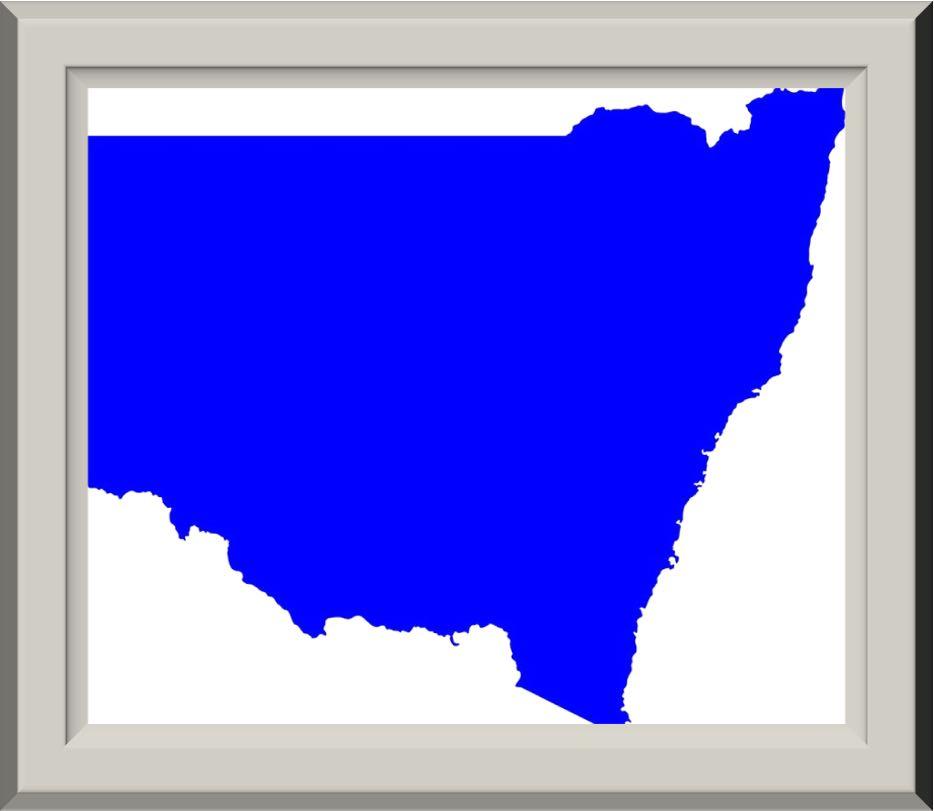
It is with sadness and regret that I have to inform you of the passing of NSW Member Greg Wise.
Greg crossed the bar at 10pm on Friday 19th April 2024 after a period of illness.
Cluey was a past President of the New South Wales Fleet Air Arm Association, and was instrumental in initiating a number of projects for the Fleet Air Arm Association, including:
• Obtaining and setting up the White Ensign and Bob Cronin buildings adjacent to the FAA Museum at HMAS Albatross.
• The initiating of the “Wall of Service” and the “Roll of Honour” plus a Memorial Garden next to the FAA Museum.
• Leading the organising teams for a number of successful FAAAA reunions.
In addition to these he was a close personal friend and mate with whom I spent many days and nights on the water fishing.
“He will be missed”
Our condolences go out to his partner Diana and the family.
Yours aye (Pincher)
R.F. Martin
NSW Division Secretary
7
WA DIVISION
SHARON SPARGO
G’day everyone,
The West Australian Division has been busy, with our Christmas meeting and lunch being very well attended. While our meetings continue to be held at Jonny Fox’s in Northbridge, our Christmas lunch venue last year was the Double Tree Hilton, which put on an amazing spread. A wonderful time was had by all. The FAA was well represented at various memorial services, including Remembrance Day in Stirling Gardens. Attending were Keith and Doria Taylor, Jim Bush, Owen Gardener, Mike Keogh and myself.
The HMAS Voyager Memorial in Kings Park, was very well attended, on what was an extremely hot day. Pictured are Jim Bush, Keith Taylor and Mike Keogh. Also present were Bill Atthowe, Greg Kelson, Ross Sarti, Doris Taylor and Sharron and Greg Spargo.
Our AGM was held this month, with Greg Kelson stepping down as President after a very impressive record of ten years at the helm of the W.A. Division. Mike Keogh has taken on that responsibility after his years as Treasurer, a position that is now taken by Dennis Nixon. Jim Bush has handed over his temporary position as Secretary, with Mick Spahn stepping into that role. Greg and Jim were roundly thanked for their contribution to
the W.A. Division, with Mike, Dennis and Mick welcomed into their new roles.
Committee members remain as Bill Atthowe as Senior Vice President and Owen Gardener as Junior Vice President, and Ross Sarti and Paul Hodgkinson coming on board. I remain the scribe.
Our annual trip to Busselton/ Margaret River is coming up on March 22, and we have a full compliment, as usual. We are all looking forward to our four days away and some serious wine and beer tasting.
Anzac Day is approaching fast and planning has begun for transporting our members around the city. At this stage our usual parade route will end on the Esplanade and veterans will be picked up after the march. An underground bar in Barrack Street is the first stop, then it’s off to Jonny Fox’s for an enjoyable afternoon, shared with members families and the recent graduates from RAAF Pearce Air Base. Our members attend various dawn or morning services throughout the metro area and my husband and I always attend the dawn service in Kings Park, with the sun rising over the city and the river and the kookaburras singing, it’s a beautiful way to start what is an amazing day of remembrance.
Lest We Forget.




8
Sharron, Roy Coulter wanted the photo and story sent through to you because he was basking in reflected glory of two of his most “extinguished” students. And because he doesn’t scrub up too badly, either!!
Roy is in the company of Vince DiPietro and me. We met up on Monday 15 Jan 24 at RAAFA Bull Creek to spin “warries and stories” going back to when Roy was the Chief Petty Officer Aircrewman and Senior Naval Officer’s Assistant at RAAF PointCookin 1976-77 when Vince and I were members of 101 Pilots Course.
Essentially, Roy was our “air daddy” while we were under training; and what an “air daddy” he was. The Navy instructors at that time were Lieutenants Dick Scott (SNO), Kev Rasmus and Mick Curry and we were being trained on the CT -4A Airtrainer (an updated version of the Victa Airtourer).
Roy was renowned for organising visits to HMAS Cerberus for his charges when the Air Force students were required to do menial tasks at Point Cook. This, of course was under the guise of “essential Naval indoctrination.”
Roy had a long career in Wessex and Trackers before leaving the Navy for various civil positions including as a prison guard, State housing manager and Customs officer, including air surveillance operating from Darwin and Broome.


Vince had a distinguished career flying helicopters, as an instructor on aircraft and helicopters, and serving in the High Commission in London (Chief of Staff to HADS) and the Embassy in Washington DC as the Naval Attaché. He was also CO HMAS Stirling,HC723Squadronand Commander Fleet Air Arm. He has been honoured with an AM and CSC and completed his service as a Commodore.
I have had a great career of 51 years in both flying and ship driving along with extensive service in international diplomacy and operational standards. I have been fortunate to have commanded a RAAF Marine SAR unit, two patrol boats, HS816Squadronand HMAS Stirling Diplomatic postings included the Embassy at Washington, DC (Staff Officer Aviation) and Seoul (Defence Attaché). My career was completed serving as Senior Officer WA on promotion to Commodore.

The third Navy member that Roy mentored who survived 101 Pilots Course, was Keith Champion. Keith flew helicopters in the Navy and Army before instructing in the UK and finally transitioning to airline flying with Virgin. He retired as a Boeing 747 Captain.
Hope this rises to Roy’s expectations. Might be worth including in our next Slipstream.
Cheers, Brett Dowsing.
9

NewsfromVictorianDivisionwith MalSmith
Greetingstoallmembersfromthe VictoriaDivision.EarlyFebruarysawus holdourAnnualGeneralMeetingatthe MissiontoSeafarers.Therewasonlyone changetothecommitteeandthelineup for2024isasfollows.
PRESIDENT ChrisFealy
VICEPRESIDENT RobGagnon
SECRETARY MalSmith
TREASURER PaulThitchener
COMMITTEE ScottMyers
COMMITTEE KenPryor
COMMITTEE JeremyButler
COMMITTEE AdrianSorensen
Thereweretwohighlightsoftheday.Kim DunstanwasawardedaDiplomaof Merit.Kimisnotacommitteemanbutis calledonregularlytoassistandisalways readytohelp.Youwillhaveseenhis nameasthecorrespondentinmanySlipstreamandFlyByarticles.I’msurehis helpisvaluedbytheeditorsofthesetwo publications.Heisafontofknowledge regardingtheFleetAirArmandis referredtoasourresidenthistorian.

RonChristieOAMstooddownfromthe committeeafteroverfortyyearsof service.Ronwasoneoftheoriginal membersoftheVictoriaDivisionandhas heldeverypositiononthecommittee includingovertwentyyearsasPresident. TohonourRon’sserviceapositionof EMERITUSPRESIDENTwascreatedand hisnameisnowproudlyplacedontopof ourletterhead.
Iattendedtheannualserviceatthe ShrineofRemembranceonthe10th Februarycommemoratingthetragic Voyager/Melbournecollision.Asalways thiswasamovingserviceandwell attended.
HMASAruntaisdueinMelbournefor ANZACDaythisyearandwehaveinvited theFAAmembersonboardtojoinusat ouraftermarchReunion/Lunch.Welook forwardtothemjoiningus.
Sunday3rd MarchwastheHMAS CerberusOpenDay.TheMelbourneNaval Committeehasastandandwehad memberstheretoansweranyquestions abouttheFAA.TheMNCareverygoodto usandwearehappytohelpthemout whenwecan.
10
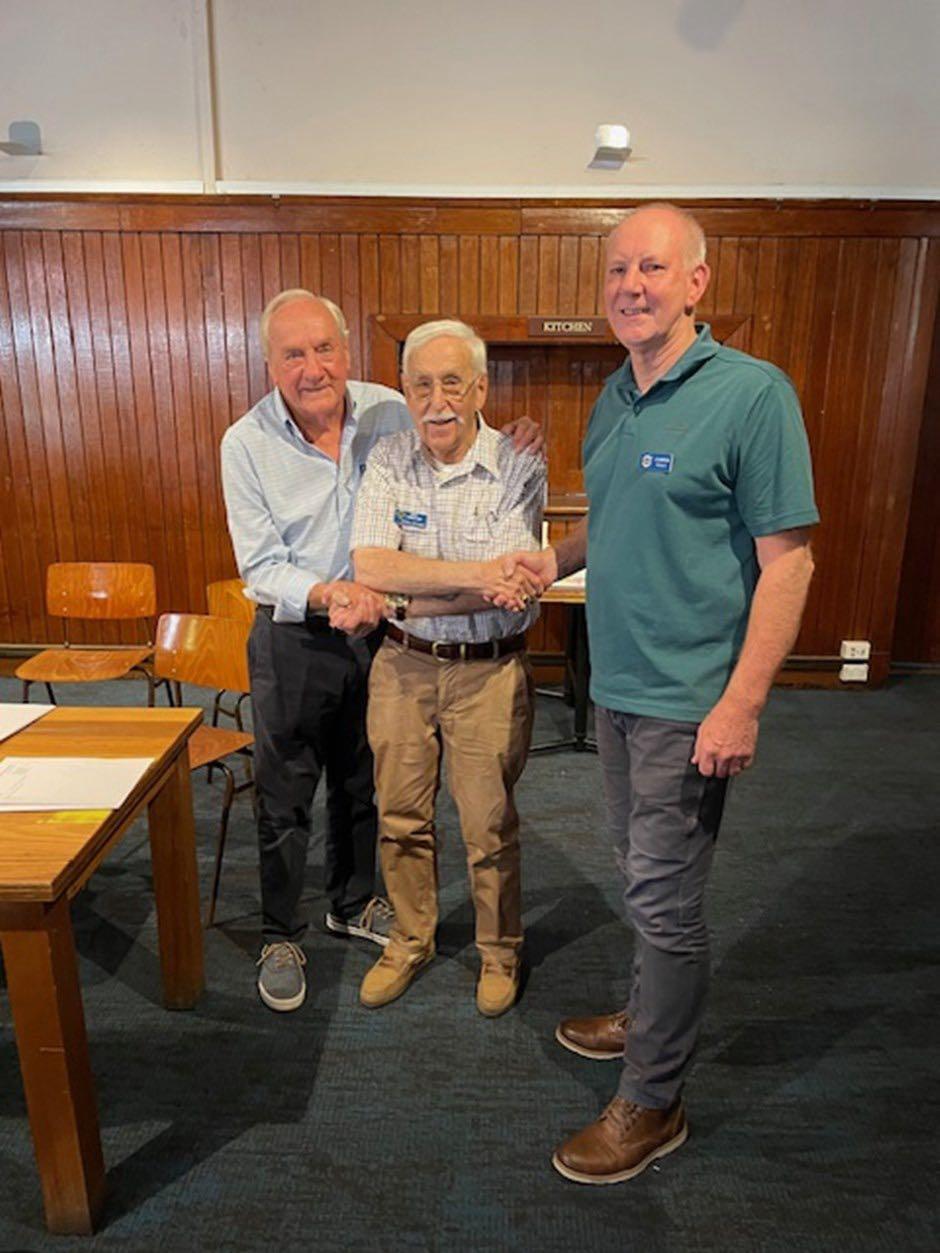
PROLIFIC HISTORIAN AND WRITER KIM DUNSTAN PROUDLY DISPLAYING HIS DIPLOMA OF MERIT, PRESENTED TO HIM AT THE VIC DIVISION 2024 AGM.

EMERITUS PRESIDENT RON CHRISTIE OAM BEING CONGRATULATED BY VICTORIAN DIVISION PRESIDENT CHRIS FEALY AND SECRETARY MAL SMITH.
CONGRATULATIONS TO RON FOR OVER FORTY YEARS OF SERVICE TO THE VICTORIAN DIVISION.

11

QUEENSLAND DIVISION REPORT
JOHN STEWART


THE FOLLOWING ADVICE HAS COME THROUGH FROM PAUL NORRIS, NATIONAL DATABASE MANAGER
The QUEENSLAND Division AGM was held on Saturday 20th April and I thought I would let you know the outcome.
Only 7 members were in attendance and apart from Stephen Huxtable, I was the youngest member there (says something about our membership demographic).
The new committee is:
President
Vice
President
Secretary
Treasurer
General Committee
Stephen Huxtable
Graham Quick
Stephen Huxtable
John Stewart
Paul Norris
Alan Arnell
Ian Henderson
Ray Murrell

12


News from SA Division with Roger Harrison

Ok, so where to start this article that will stitch together all that stuff that’s been happening at the end of last year and into this new year and all done behind your backs.
Firstly, a warm welcome to the FAAA Family and to the newcomers who are reading the Slipstream for the first time. Welcome.
Last December this Division had it’s Christmas lunch at The Windsor Hotel. We had 18 faithful Members and partners/mistresses join our table with a dozen of our regulars putting in their apologies for not being able to attend. The lunch proceeded in its normal form with a good meal, buffet bar and drinks. No silly hats to wear I was pleased to find. Not noisy so easy to have the normal chatter one expects without the shouting necessary.
December also saw the passing of South Australian Member, CMDR Brian Dutch who had the good fortune to reach the great old age of 90 years. We should be so lucky. I think Slipstream covered Brian’s passing in the last edition. Will check it out.
December also sees the FAAA (SA) Membership Renewals rear its head once more and all Members would have received 2 x emails with Renewal details all made very clear. So, reading this Slipstream in April 2024 and having not renewed your Membership is risky as our debt collector Felonious, will pay you a visit one early morning.
January 2024 saw the first General Meeting for this year held at the Wittunga Botanic Park, Blackwood on Sunday 21st at 1130H. A BYO everything and this included some excellent cool weather of 26 degrees. Those attending were President John and Anna Siebert, Ian McBeath, Vic Byers, Darryl and Julie Ward, Dee and Ian Laidler, Katherine, and Michael Cain and the whipping boy. Several apologies were received including Henry Young who is into his 101st year, slope off for his tennis coaching. An excellent day of bonding and fellowship.
13
January 31st saw John Siebert, Ian Laidler and me, travel to Murray Bridge to visit our past President, Michael ‘Stubbo’ Stubbington who has recently been relocated to the RSL Romani Old Farts Home which is slick and brand new. An exercise to get into the place but we persevered after an RAT check and then photographed for the Visitors badge. Directed to his comfortable room where we found him relaxed and contemplating the end of the world. We thought he looked well although complaining of an injured wrist. After exhausting all current conversation, we departed and threatened him with a return visit in a few weeks’ time.
An Invitation has been sent to all SA Members from the Port Adelaide Naval Association Sub-Section to come along and mix it with the Real Navy over a meal, drinks, and entertainment. Trusting the entertainment won’t take the form of the Dance of the Flaming A*****s

This all happens on the 16th of February and the Naval Association will go out of their way to make us all welcome in our request to have a closer connection with other SA Naval Groups. They have saved us a table for 20 Members. Details in the following Slipstream.
March the 20th will see us assembled at the Keswick Barracks for our GM and AGM before or during our light lunch, due to the President having a scheduled medical appointment around that time. We can make all manner of promises and tell the newly re-elected President later. An Agenda will be forwarded to all Members in early March.
The May 15th GM should still be a lunch meeting at the Keswick Barracks unless the State Government have sold it off sooner than expected. Valuable property sitting there gathering dust and as most State Governments are short for funds, grab this property and flog it off to developers ASAP. Will forward Flash Messages to local FAAA Members if this happens.
Most Adam and iiNet e-mail users will, by now, be unable to use that platform as intended. My old e-mail address has finally been chopped and now I am relying on Gmail to keep me connected with the wide world web so to speak. What a joy transferring all of those contacts and details from coroman@adam.com.au to harrisonrd45@gmail.com You only need to do it once, I have 100 plus to transfer, but who’s complaining? And that’s another thing. Marcus has pointed out that my cleverly thought-out e-mail address now clearly tells him my full name, initials and how old I am. Bugga! Nobody likes a smarty-pants, Marcus.
Will finish off rambling with the strongest wish from this SA Division to yours, for a successful year with good fortune, good health, and happiness to all Members near and far. Also hoping our Qld cousins have reverted to a stable climate with less cyclones, heavy rain, and flooding. I will miss-quote the rant of “Wonderful one day, better the next”?
14
LETTER TO THE EDITOR FROM ROGER HARRISON.
The 10th of February 2024 marked 60 years since the Voyager/Melbourne collision with the result of 82 lives lost.
The fact that the Royal Australian Navy, the then elected Government and Queens Council to the two Royal Commissions acted disgracefully as a major cover-up was set into motion by government and Navy. The Commission found HMAS Voyager's actions on that night to be "inexplicable" and yet HMAS Melbourne and its bridge officers were charged with some of the blame.
Captain Duncan Stevens, HMAS Voyager, had been found to be "unfit to command." In fact Captain Stevens was a chronic drunkard combined with a serious stomach ulcer. As a result his responsibility towards his ship and crew were always put at some risk as demonstrated near Jervis Bay on that evening of the 10th February 1964.
It eventually took Lieutenant Commander Peter Cabban (FAA) to step up and bring forward the true reasons for the largest loss of life in Australian peacetime history. This is a saga of dishonour and corruption at the highest levels of government and public service as well as pointing the finger at some very senior RAN Officers who closed ranks behind the memory of Captain Duncan Stevens RAN


SA Member Henry Young (100 years old) was interviewed on The Front Bar, Channel 7 on 15th February alongside tennis champion Pat Cash. A short interview where Henry spoke about his health, hearing loss and his early Navy FAA career. Henry is a veteran tennis champion and he shared some anecdotes with Aussie sports icon Pat Cash.

15

NEWS FROM THE RANHFV
PTE. PATRICK HALLEY RECEIVES
RANHFV GUNNER’S WINGS
HOBART, TASMANIA 17TH April 2024
At a 2 RAR Reunion last year Rob Carmichael met up with Pat Halley who was also one of the 2 RAR Infantrymen who "volunteered" to be a 135th door gunner. ‘Beachball’ Godfrey got the ball rolling with the end result of Pat being presented with his Gunner's Wings with certificate and his Unit Citation for Gallantry.
Many thanks to COMFAA’s Staff Officer, Commander Damien Liberale who arranged with Commander Tony Everingham RAN, Officer OIC Tasmania, for the presentation. Also many thanks to Tony, his First Lieutenant Jacob Elsford and his team for the day's effort. BZ all, the presentation was conducted in the true tradition of the RAN.
Graham Halton OAM
President Tasmania
Australian Federation of TPI
Ex-Servicemen and Women


16
CMDR Everingham reads the citation for Patrick’s Gunner’s Wings
Graham Halton, Patrick Halley and CMDR Tony Everingham

NEWS FROM THE RANHFV
PETER RUHL – 3rd Contingent
In March former CPOATWO Peter Ruhl passed away in Wollongong hospital following a long illness. Whilst serving with the RANHFV Peter met and fell in love with Rosemary, a South Vietnamese interpreter working with the EMU’s. In what must rate as the most efficient severing of military red tape ever, Peter and Rosemary were married with the combined blessings of the OIC RANHFV, LCDR David Farthing and the US Army CO 135th AHC, Major Walter Alexander. Peter & Rosemary had two sons and a daughter.
Here is how CDRE David Farthing DSC, RAN (rtd) recently described their wedding:
“The Australian Government sent a very firm instruction that the marriage was NOT repeat NOT to take place!! I spoke to our US CO, Walter Alexander, who had already been ordered that this marriage was NOT repeat NOT to take place. It really had nothing to do with the Americans as those involved were Australian and Vietnamese! However, both Walter and I were really tired, and we decided to tell both our governments to get “nicked.”
The next Saturday was a Company stand-down and Walter organized the Battalion priest to come to Bear Cat and perform a marriage in the Mess Hall. It was a very successful event, everyone enjoyed themselves. Amazingly, there were no repercussions from higher authority!!”
KEITH DONCON—4th Contingent
Keith passed away on Saturday 20th April in Perth. Long-time friend Greg Kelson has written this dedication to Keith, who was a Leading Electrical Mechanic Air Weapons with the 4th Contingent.
Did I know Keith Edward Doncon, R55188, Leading Electrical Mechanic? I don’t remember when I met Donc, he was just there. I don’t recall serving on a squadron or part of ship with him, he was just there. After a rugby match, to the Sportsman Club, he was just there. At one time we were both members of Lodge Albatross 575. He was a popular barman at the Junior Sailors Club on the staff for Lyle “Pop” Stark. Very popular amongst the WRANS. He in fact married a WRAN Cook, supposedly to have a variety of menu, instead of self cooking. He and Kay were promoted Leading Hand on the same day, and as Kay fronted the Captain’s table first, she became senior to ‘rawbone’ Keith.
Donc served with the EMU’s in Viet Nam. I did not; so others that were there can relate of that experience.
When the Doncons separated from the Navy, Keith obtained employment with the Postmaster General’s Department, as a telephone technician (linesman). Many years later, Anne and I met up with them again in Mandurah, WA. Keith had retired and Kay‘s health was fading fast. We each resumed our friendship where we left of, as if Donc had always been there.
When Kay died, Donc spent his time and talents with Legacy Widows group in Mandurah district.
For holidays he travelled to Bali. Once there he was struck by the children in the local orphanage, so much so then when back home he contacted many of his mates, asking donations of clean serviceable clothing. This was his program for a lot of years. Subsequently he became known and accepted by the Staff and Government Officials and was always greeted by Airport and Customs people. He would take all the kids to the local McDonalds for ice cream. He then became known as Poppy Ice Cream.
One time, at his hotel, the waitress he befriended was evidently in some dental pain, she could not afford treatment. Donc made arrangements at the Clinic, bundled her off, treatment done and dusted, he picked up the tab. Friends for life. She and her husband and three kids virtually adopted him. Or did he adopt them? Forgive my lack of names, for Donc only ever spoke of them as his ‘Bali family’. He encouraged the husband to self-reliance, stood by and backed him in land purchase and built a modest cottage for themselves and two more for renting. As time went by he sponsored the three children through Queensland University.
Since the Covid pandemic lockdown, Keith’s visits to Bali became less frequent, his own health problems began to assail his vital organs, he became rather reclusive, until Donc’s son Troy had to take charge and seek more professional assistance. The last year of his life was rather harrowing, yet there were negative complaints from Donc.
How many lives has he touched ?? Do they, like me, ask “Are you there Donc ???”
17

60TH ANNIVERSARY OF THE LOSS OF HMAS VOYAGER
At a commemoration service held on 10th February by the Shoalhaven-based Keith Payne VC Veterans’ Benefit Group, Captain Andrew Whittaker RAN (rtd) delivered the following address.
Sixty years ago, the Royal Australian Navy experienced its worst ever peacetime disaster, with the loss of 82 lives.
The night of 10th of February 1964 was clear but moonless, with light winds, when the destroyer HMAS Voyager was sliced in two by the bow of the aircraft carrier HMAS Melbourne off Jervis Bay.
Both Melbourne and Voyager had recently completed extended refits and major crew changes. They were both carrying a large number of personnel who had never been to sea before, 184 ordinary seamen in the case of Melbourne and 72 aboard Voyager. Additionally, 39% of Melbourne’s officers had been in the ship less than three months and she had a new captain.
Chief Coxswain Rogers, aboard Voyager, had expressed concern to several officers about the loss of experienced sailors and their replacement with trainees.
The 10th of February was the first close quarters manoeuvring either ship had experienced in over six months. To add additional pressure, Melbourne was to conduct flying operations to work up the carrier air group which was disembarked at Naval Air Station Nowra.
Gannet and Sea Venom aircraft were scheduled to conduct night deck landing practice, however due to the light and variable wind, the carrier had problems getting sufficient wind over the deck to conduct flying operations and had to abandon the first deck landing sortie.
Melbourne went hunting for a better course with sufficient wind and during this manoeuvring, Melbourne and Voyager, had been turning in unison onto the different courses.
After the initial flying sortie being on a southerly course, Melbourne settled on a flying course of 020 and at 2052 hours, radioed Voyager to take up plane guard position (to rescue the crew of any ditched aircraft) with a flying course of 020 degrees at 22 knots. Voyager at that time was fine on the starboard bow of Melbourne at a range of 1500 yards and had to take up a position on Melbourne’s port quarter at 1000 – 1500 yards. Voyager was seen to make an almost immediate turn to starboard, as expected. There was less than four minutes to impact.
Those on Melbourne’s bridge expected Voyager to either make a right hand 360 degree turn, crossing Melbourne’s wake to take up position, or a fish-tail manoeuvre, where Voyager would turn to starboard, allow Melbourne to advance, then turn to port and cross the carrier’s wake.
Fatefully, Voyager only completed a relatively shallow turn to starboard, before turning to port, on a course that would bring her directly in front of the carrier. With less than a minute to impact, the carrier’s captain ordered “full astern both engines”, but this would only have slowed the ship by about one knot
at the point of impact. Aboard Voyager, it was with only 20 seconds to impact that the order was given, “hard a starboard, full ahead both engines”.
Almost 16,000 tons of aircraft carrier, travelling at 21 knots, struck the 2,800 ton destroyer beam on, just aft of the bridge, pushing it sideways through the water before cutting the ship in two. All but one of those on the bridge and in the operations room below the bridge, were killed, making it difficult for inquiries and royal commissions to determine exactly what happened during those fateful four minutes between receiving the order to take up plane guard position and impact.
One of the survivors from the bow section, Leading Radio Mechanic John Milliner, was playing tombola (bingo) in the café, where Chief Coxswain Rogers was calling the numbers. He recalled there was a garbled pipe seconds before the impact and then the ship rolled violently. Due to the weight of the twin fore turrets, the severed bow section almost completely capsized and Milliner was disoriented in total darkness.
He was among the fortunate ones who were able to climb out of an escape hatch and later wrote:
“I was ecstatic to be out of that dark tomb and slid thankfully down the hull into the water. I swam away but when I turned around to look back, the bow, which was protruding from the water,
18

rolled towards me I swam away from it in panic and when exhausted, I looked again and saw the bow sink below the waves. This was the most horrific sight I have ever witnessed.”
Of the 314 aboard Voyager, 14 officers, 67 sailors, and one civilian dockyard worker, 82 in total, were killed. Most died immediately or were trapped in the bow section, which sank after 10 minutes. The stern section of the ship sank just after midnight. Melbourne, although damaged, suffered no fatalities, and was able to sail to Sydney the next morning with most of the Voyager survivors aboard – others had been taken ashore, mainly to the naval base HMAS Creswell.

There were many brave actions that night by crews from both ships, search and rescue boats from HMAS Creswell and helicopters from HMAS Albatross. Chief Petty Officer Jonathan Rogers was posthumously awarded the George Cross, the equivalent to the Victoria Cross for non-warlike gallantry during the sinking. Recognising that he was too large to fit through the escape hatch, he organised the evacuation of those who could escape.
Another of the survivors from the forward section, Able Seaman Matthews, told the Royal Commission:
“I could hear the coxswain, CPO Rogers in the forward café, organising the escape of all the young fellows on the ship. I could hear him telling them not to
The daughters of CPOCOX Jonathan Rogers GC, DSM, Rhonda and June with Keith Payne VC, AM
panic and he led them in a prayer and a hymn”
Posthumous Albert Medals for Lifesaving were awarded to Midshipman Kerry Marien and Electrical Mechanic William Condon for their actions in saving others at the cost of their own lives.
As well as the George Cross and two Albert Medals, a George Medal, five British Empire Medals for Gallantry, and three Queen's Commendations for Brave Conduct were awarded to Voyager personnel.
While conducting the oral history project for the Keith Payne VC Veterans Benefit Group, a number of people were interviewed who were aboard Melbourne for the collisions with HMAS Voyager and/or USS Frank E Evans, and
some are here today.
Brian Carroll told of being in Melbourne’s forward Petty Officers’ mess and of flames roaring up Melbourne’s hawser pipe when one of Voyager’s boilers exploded.
Another of those interviewed had only joined Melbourne in Jervis Bay on the morning of the collision with Voyager. It was his first night at sea and he was with several others on a catwalk outboard of and below the island, watching the manoeuvres and night flying. It was with horror he watched Voyager go under Melbourne’s bow.
He clearly remembers hearing ‘Buck’ Rogers singing “Abide with me” and the recovery of oil soaked survivors. In the interview, he also spoke of getting back to Sydney. After Voyager’s survivors had gone ashore, many of Melbourne’s crew were given short leave. This was an era where sailors were required to be in uniform when they went ashore.
A crowd had gathered outside Garden Island and as the sailors exited the base, they were called murderers, spat on and kicked; much like many returning Viet Nam veterans. He is still scarred by both the collision and the treatment meted out by his countrymen.
As we commemorate the 82 who lost their lives, we also remember the survivors of both ships, who have lived with the memory of that fateful night for the last 60 years. Voyager’s Latin motto Quo Fata Vocant, poignantly translates as ‘WHERE FATE CALLS’
19
NEWS, VIEWS AND REVIEWS FROM AROUND THE CORNER
AND ACROSS THE GLOBE
It is with great sadness that we mark the passing of Rear Admiral Guy Richmond Griffiths, AO, DSO, DSC, at the age of 101.

RADM Griffiths was the eldest surviving officer who saw active service in WWII, including the sinking of HMS Repulse at Singapore and the battle of Leyte Gulf onboard HMAS Shropshire.
A distinguished career followed including active service in the Korean War as Gunnery Officer in HMAS Sydney and then in HMAS Anzac. He was the first to command HMAS Parramatta II and was one of the very few officers to command a frigate, a destroyer,

and an aircraft carrier during his career. In 1967 HMAS Hobart, under Griffiths’ command, became the first RAN destroyer to take part in the Vietnam War. The ship spent 160 days at sea in her 204 day deployment.
As Commodore Griffiths, he commanded the Australian flag-ship HMAS Melbourne during Operation ‘Navy Help Darwin’ and for Exercise ‘Kangaroo I’. He retired from the Royal Australian Navy in 1980, after 43 years of service, as a Rear Admiral and as the Flag Officer Naval Support Command.
In later life, he became the National President of the Australian Veterans and Defence Services Council as well as the CEO of the North Shore Heart Research Foundation.
Rear Admiral Guy Richmond Griffiths, AO, DSO, DSC, made a significant contribution to the Royal Australian Navy and to our nation during his long life. He leaves behind an incredible and enduring legacy. His full obituary is at: https://navalinstitute.com.au/ obituary-radm-guy-griffiths/

20
CN, VADM Mark Hammond celebrates with RADM Griffiths on the occasion of his 100th birthday
NEWS, VIEWS AND REVIEWS FROM AROUND THE CORNER
AND ACROSS THE GLOBE
First autonomous undersea vehicle ‘Ghost Shark’ prototype ready

Ghost Shark will provide Navy with a stealthy, long-range autonomous undersea warfare capability that can conduct persistent intelligence, surveillance, reconnaissance and strike. It will also enhance Navy’s ability to operate with allies and partners.

The Albanese Government will deliver a sovereign, autonomous undersea capability, through the Ghost Shark Program.
Ghost Shark is being jointly developed and funded by a partnership between Defence and Anduril Australia, and will become Mission Zero (0) for the Advanced Strategic Capabilities Accelerator (ASCA).
Only Defence’s highest priorities are used to select ASCA missions and there must be an identified pathway for the innovation to transition to capability.
Ten Australian companies have partnered with Anduril Australia to be ready for the manufacture of Ghost Shark, and there are 42 Australian companies who stand to benefit in the supply chain.
The Ghost Shark will form part of the Albanese Government’s investment of up to $7.2 billion for the development and acquisition of subsea warfare capabilities and new autonomous and uncrewed maritime vehicles. The Government is spending more than $10 billion on autonomous and uncrewed systems, including armed systems, as part of a comprehensive plan to provide the ADF with capabilities it needs to meet strategic circumstances.
Navy will also explore the potential for synergies between Navy’s XL-AUV program and future trilateral collaboration through AUKUS Advanced
Minister for Defence Industry, Pat Conroy:
“GhostSharkisanexemplarofhowDefence andAustralianindustrycanmoveatspeedto developnewsovereigncapabilitiestorespond tothechallengesbeforeus.
“ASCAisfocussedonspeedingupthetransition ofinnovationintocapabilitythatwillgiveour AustralianDefenceForceanedge,while creatingmorejobsforAustralians commercialisingthetechnology.”
Chief of Navy, Vice Admiral Mark Hammond:
“Weareanationgirtbysea,andtheGhost Sharkisoneofthetoolswearedevelopingfor theNavytopatrolandprotectouroceansand ourconnectiontotheworld.”
21
Minister for Defence Industry Pat Conroy at the unveiling of Ghost Shark, Garden Island
NEWS, VIEWS AND REVIEWS FROM AROUND THE CORNER AND
ACROSS THE GLOBE

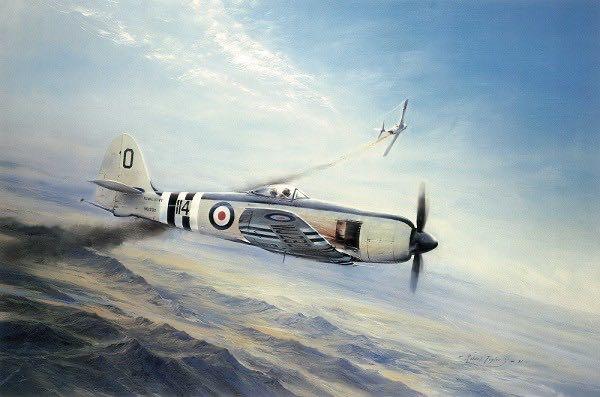
KOREAN MiG HUNTERS
There are few dogfights in the history of aerial combat which stand out. One of those is that in which a Fleet Air Arm Sea Fury downed a MiG15 in Korean War.
Carl Haines, who recently passed away, was involved in that fight and left us with a little more information. Carl Edward Haines was born in Hoo, Kent, on 23 March 1931. He was adopted as a child, but eventually became estranged from the family that brought him up. Later in life he made contact with his birth-mother and found that he had a half-sister named Joan.
Educated at the Headlands Secondary School in Swindon, Wiltshire, Carl took a strong interest in maths and history and was considered to be a bright, but mischievous boy. An avid reader,
he also enjoyed sport, singing and a keen trainspotter. During WWII he and his friends would search bombsites unexploded bombs and bullets.
He passed his school certificate in 1947, and applied to join the Fleet Air Arm, inspired by stories of those who had flown during the war, and began flying training in 1949. Moving to RNAS Culdrose, in Cornwall Carl met Doreen Humphreys, a factory worker, at a dance. He sold his precious stamp collection to raise funds to make an impression on their first date. It obviously worked and they were married in the Air Station Chapel in the Summer 1951.
21 year old Carl was appointed to 802 NAS, flying the Hawker Sea Fury FBII. The aircraft was one of the most potent propeller driven fighters, but when the squadron embarked in HMS Ocean and sailed for Korea, they would be up against faster Russian-built jets.
22
Launching at 05.25 on the morning of 9 August 1952, Carl was part of four fighters on a routine dawn patrol between Chinnampo and Pyongyang. The formation was led by WWII veteran Lt. Peter ‘Hoagy’ Carmichael, the other pilots were Lt. Peter Davis and his wingman, S.Lt Brian “Smoo” Ellis. They were looking for ‘targets of opportunity’ such as looking for railway engines and rolling stock, transport and bridges. But, as the sun burnt off the morning mist, Carl was the first to spot eight MiG-15s, at a slightly higher altitude, so silhouetted against the setting sun, and transmitted “MiGs four o’clock high.”
An entry in the 802 NAS Diary says, “The bogies were identified as MiGs and they were closing. By this time, [the Furies] drop tanks were fluttering earthwards and the flight had assumed proper battle formation.”
Ellis noticed a shower of red tracer streaming past both sides of his fuselage, and cried ‘Break’ over the R/T and the flight commenced a defensive manoeuvre known as ‘Scissors’. The two formations split in two, and each pair of Sea Furies were engaged by four MiGs, but by continuing their break turns the naval aircraft presented almost impossible targets.
A MiG came head-on to Carmichael and Haines who both opened fire; it broke away and proceeded to go head-on to Davies Ellis, who also fired and registered hits. Another MiG pulled up in front of Ellis, with its air brakes out, and he was amused to find the range closing. He gave a long burst and noticed hits on the enemy’s wings. The jet turned northwards at a reduced speed, and left the area with two other MiGs in company. The whole engagement last 4-5 mins. One of the jets crashed into a hillside and blew up, two or three others were damaged.
This was the first time Royal Navy fighters had shot down an enemy aircraft during the Korean War and, more remarkably, it had been achieved by propeller-driven aircraft against jet fighters.
All four Sea Furies landed back onboard HMS Ocean, where the pilots received an ecstatic welcome. The destruction of a MiG-15 became a source of pride for the Fleet Air Arm but also
one of controversy. All four pilots claimed a share of the “kill”, however, by convention Carmichael, as flight leader, was given credit for destroying the MiG and awarded a DSC. He was sent home early to be fêted in Britain.
Today, it is generally accepted as it was among many naval aviators in 1952 that the man responsible was ‘Smoo’ Ellis, thanks to the sharp eyes of Haines.
Carl flew a total of 175 missions in Korea with 804 NAS onboard HMS Glory and 802 NAS HMS Ocean. This exceeded the number of sorties allowed in Korea and he was sent home where he flew with several other squadrons and qualified as a test pilot.

His service records and logbooks record that he flew a total of 1,473 hrs with the Fleet Air Arm between 1949 and 1956 and carried out 332 deck landings on aircraft carriers.
The issue of who had delivered the decisive blow that brought down the MiG-15 was later investigated by author Paul Beaver, who revealed the Royal Navy’s only “MiG killer” was in fact Ellis, not Carmichael, and provided a detailed account of the action. He also singled out the key role played by Carl Haines, who had first seen the eight enemy jets.
When Ellis, himself, was interviewed by Roland White, he said, “Carl saved us. He saw something move against a pale daylight moon, which gives you an idea of how sharp he was. If you want somebody who needs a lot of credit, there’s the first guy, because we immediately got into a pretty fair battle formation.”
The final note should go to Carl himself, who recording in his logbook the destruction of the MiG and the damage inflicted on three others, wrote in neat capital letters, “NUFF SAID!”
Carl Edward Haines died on 1 June 2023, aged 92. RIP
23
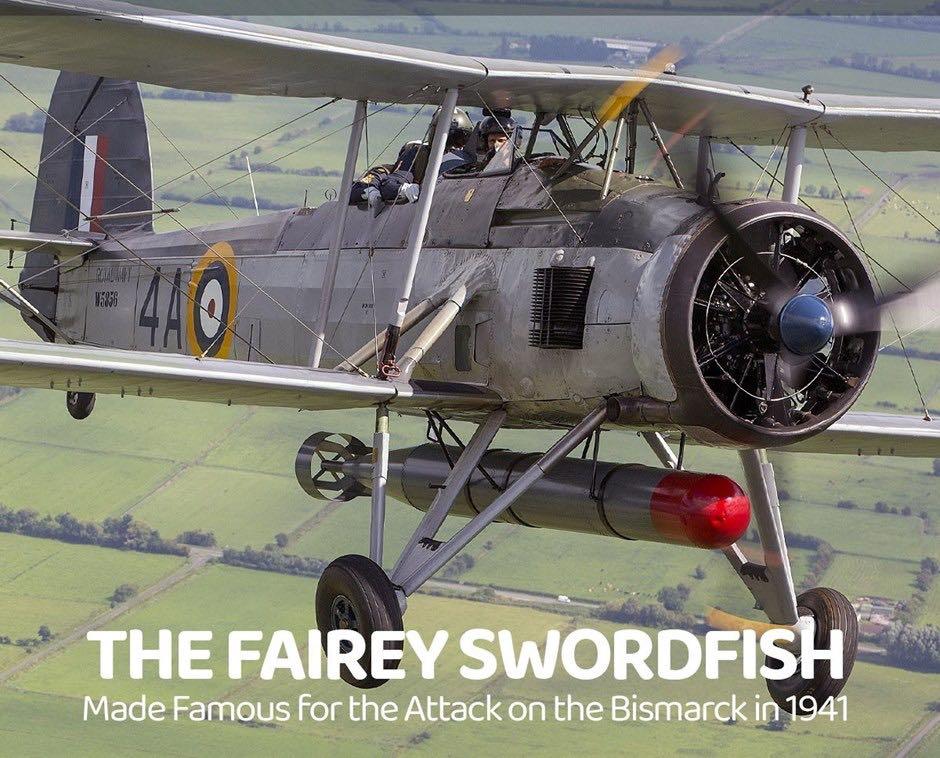
The Fairey design for the Swordfish began as a private venture to satisfy a need to replace Greek Fairey IIIF aircraft. The original was known as the TSR1 (Torpedo Spotter Reconnaissance), but was not too successful and was significantly re-designed as the TSR2 and re-engined with the Bristol Pegasus before being regarded as satisfactory. This aircraft first flew in 1934 and was taken into Royal Navy service in 1936 as the Swordfish Mk.I.
By the start of WWII, technology had moved on apace and it was already regarded as obsolete, but with a large number already in service it was nonetheless put to good use. It earned its nickname ‘Stringbag’ because, like the shopping bags of the day, it could accommodate practically anything. It could carry a 1,610lb torpedo or a variety of depth charges, bombs, mines, rockets or flares.

24
T
The German battleship Bismarck has been described in superlative terms ever since she sank the “Pride of the Royal Navy,” the venerable battle cruiser HMS Hood at the 24 May 1941 Battle of the Denmark Strait and drove the new British battleship Prince of Wales from the scene of the fight. At the time, the Bismarck was widely viewed as the most powerful vessel afloat, as well as the largest, fastest, and most protected warship in the world.

Hit by three shells in return, Bismarck had set course for the port of Brest, in occupied France, to undergo repairs. The only warships that could pose a threat were hundreds of miles away. Then, at dusk, out of a rainsquall, skimming just above the waves at a leisurely pace, appeared what must have seemed phantoms from the previous war: nine Fairey Swordfish biplanes from the aircraft carrier Victorious, their crews’ heads leaning out of open cockpits. Bismarck’s Captain Ernst Lindemann ordered the helm put hard over. He knew that while the biplanes might be obsolete, the torpedoes they carried were not. The battleship’s anti-aircraft guns unleashed an intense barrage. No planes were shot down, but only one torpedo scored a hit, amidships on the main armour belt, with negligible effect. Bismarck’s crew probably wondered why, in the third year of the war, the Royal Navy had only sent a handful of antique aircraft against them. Tomorrow, they would be close to France, protected by the Luftwaffe and a line of U-boats.
For the British there remained one last, desperate chance to attack. With darkness falling, another flight of 15 Swordfish managed to take off from the wildly pitching deck of the carrier Ark Royal into 70 mph winds. One of their torpedoes again fruitlessly hit the armour belt, but, as Bismarck turned hard to port, a second struck its vulnerable stern. With its rudder jammed, the great ship could only steam in circles. The next day, May 27, the battleships King George V and Rodney, together with several cruisers, appeared on the horizon. Bismarck put up a brave fight, but eventually joined Hood on the ocean floor.

25
Pride of the Kriegsmarine, the Battleship BISMARCK
The Swordfish’s greatest single achievement came seven months later. The Italian navy’s fleet of fast, modern warships six battleships, nine heavy cruisers and multiple destroyers was twice the size of the British Mediterranean fleet. From its main base in Taranto it could threaten key British bases such as Malta, Gibraltar and Alexandria; cut off vital oil from the Middle East; and jeopardise supplies for the British fighting the Italian army in North Africa Taranto boasted one of the world’s most heavily defended harbors, with hundreds of anti-aircraft guns in shore batteries and on the warships themselves. Barrage balloon cables encircled the anchorage to snare low-flying aircraft, and tests had indicated the harbor waters were too shallow for aerial torpedoes, which simply plunged into the mud.
On the night of November 11, 1940, against this seem-
exploded. Caio Duilio took three torpedoes and sank. Despite 14,000 anti-aircraft shells being fired, only two planes were lost, with one crew surviving.
In March 1941, the Italian navy sought revenge against the British in the Mediterranean, leading to the Battle of Cape Matapan. The battleship Vittorio Veneto, eight cruisers and 14 destroyers set out to intercept Admiral Andrew Cunningham’s fleet. British cryptographers, having just broken the Italian naval code, alerted Cunningham. The heavy cruiser Pola was brought to a stop by torpedoes from Formidable’s Swordfish Vittorio Veneto, hit in the stern and with one propeller smashed, almost suffered Bismarck’s fate, but limped back to its harbor, leaving orders for the cruisers Zara and Fiume and two destroyers to stand by the stricken Pola. That night Cunningham’s ships sank all five. The Italian fleet
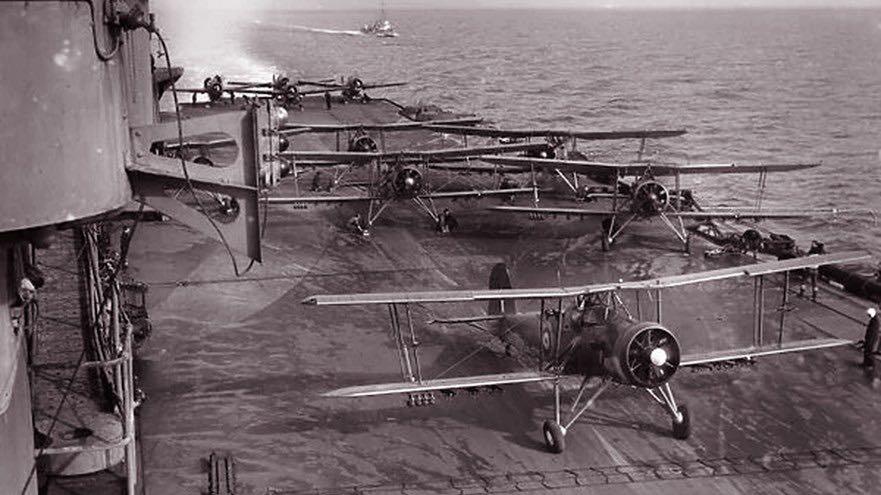
ingly impregnable fortress, Illustrious launched 20 Swordfish, armed either with torpedoes (modified for shallow water), bombs or flares to illuminate the targets.
Pilot Lt. Cmdr. John Godley wrote: “It’s hard to understand how such a decision was ever made. The Charge of the Light Brigade…can it really not have been foreseen that the entire mad venture would end in disaster?” The element of surprise was lost when one plane arrived early, alerting gun and searchlight crews. In the face of intense anti-aircraft fire, the Swordfish torpedoed the battleships Littorio putting it out of action for the rest of the war Conte di Cavour and Caio Duilio, plus a cruiser and several destroyers. Conte di Cavour
never again posed a threat to the Royal Navy. Taranto was momentous in its implications. A handful of carrier aircraft had reversed the naval balance in the Mediterranean, literally overnight. Together with Cape Matapan, it signalled that the days of the battleship as supreme warship were over, that aircraft carriers would play the decisive role in future naval battles and that a powerful fleet in a heavily defended harbor could be devastated by aircraft. Taranto’s significance was recognized in Japan, but apparently not in the United States. A year later, the aerial attack was repeated on a grand scale at Pearl Harbor.
26

Navy Heritage Flight
While on the subject of the Fairey ‘Swordfish’, the HARS Navy Heritage Flight was delighted to host ex-RAN and RN Reserve pilot Andrew ‘Mum’ Davis in late December last year. By special arrangement, Andrew was able to get airborne in Tracker 844 whilst it flew over the funeral cortege of the late CAPT Theo Burdorf RAN, himself a Grumman Tracker observer and former 851 Squadron Commanding Officer (1975-1976).
Andrew Davis joined the Royal Australian Navy in 1978 and was awarded his Navy Wings in 1979. Despite picking up an unfortunate nickname of ‘Mum’, he embarked upon carrier flying operations in HMAS Melbourne and he was privileged to enjoy over 250 arrested landings onboard flying S-2G Tracker ASW aircraft.
Upon the demise of Australian Naval fixed wing flying in 1984, he came to the UK for a RN exchange tour flying Seaking Helos, also in the ASW role.
Andrew transferred fully to the Royal Navy in 1987 completing fast jet training in 1988. Sea Harrier FRS1 and FA2 operations including Op Granby and Deny Flight and these were interspersed with Flying Instruction duties on Tucano, Hawk, Grob and Sea Harrier.
Ending his regular career as CO Naval Flying Standards Flight (FW) in 2004 and joining Virgin Atlantic Airways, he has continued in RN Reserve (Air Branch) service enjoying Hawk T1 flying as a part timer for many years. Initially a volunteer pilot for Navy Wings, he became Chief Pilot in 2020 and now thoroughly enjoys being part of the day to day flying of all current Navy Wings aircraft, and in particular the Fairey ‘Swordfish’.

Andrew back in the Grumman ‘office’. He is now the Chief Pilot with ‘Navy Wings’ in the UK, successor to the Royal Navy Historic Flight.
Tracker crew reunite
December 2023
L – R Steve McMahon
Keith Boundy
Don ‘Stumpy’ McLean
Andrew ‘Mum” Davis
Owen Nicholls
Garry Holloway

27

IT ’ S A COMPELLING QUESTION

28
NEWS, VIEWS AND REVIEWS FROM AROUND THE CORNER
AND ACROSS THE GLOBE

MIDSHIPMEN AND THE GALLIPOLI CONNECTION



Two RN Midshipmen, George Leslie Drewry (above) and Wilfred St Auburn Malleson (left) were each awarded the Victoria Cross for valour on 25 April, when attached to the Troopship River Clyde. Both midshipmen entered the water to secure lighters to the beached River Clyde, to bridge the gap between the River Clyde and the shore, for troop disembarkation. The initial landings of the Dublin Fusiliers and the Munster Fusiliers were met by devastating Turkish fire. However, all attempts to land further troops proved abortive, resulting only in carnage. The troops on the beach and those still on the River Clyde had no option but to stay where they were until nightfall. Attempts were made to rescue at least a few of the many wounded. An RN commander and several other sailors were also awarded Victoria Crosses in this action.
29
NEWS, VIEWS AND REVIEWS FROM AROUND THE CORNER
AND ACROSS THE GLOBE

Former US Navy F/A-18 pilot explains why, although during his era the Hornet was the best airplane on the carrier, his fun meter was most pegged flying the A-4 Skyhawk.
Douglas built 2,960 A-4 Skyhawk attack aircraft between 1954 and 1979.
Built small to be cost effective and so that more of them could be accommodated on a carrier, the lightweight, highspeed bombers were affectionately nicknamed “Heinemann’s Hot Rod” (after Douglas designer Ed Heinemann), the “Bantam Bomber”, “Mighty Mite” and “Scooter”. Skyhawks provided the US Navy and Marines and friendly nations with manoeuvrable, yet powerful, attack bombers with great altitude and range capabilities, plus an unusual flexibility in armament capacity.
Given its unique capabilities, what was it like to fly the A-4 Skyhawk?
Jim Danhakl, former US Navy F/A-18 Hornet pilot, recalls:
‘During my era the F/A-18 was the king of the hill. It was by far the best airplane on the carrier. We used to eat Tomcats for lunch in a dogfight and the missions, both air to air and air to ground, were more diverse and challenging.
I also loved being single seat and the pride that comes with “doing it all”.
‘But I will say this – and I know a lot of other Navy guys that would say the same thing –my fun meter was probably most pegged flying the A-4 Skyhawk.
‘Maybe it was first love, maybe it’s the way you slid in the jet and wore it vice larger cockpits that felt more rub-a-dub -dub. But the A-4 was a performer – especially the big engine A-4F. We fought against adversaries who flew those all the time and I’ve been embarrassed by those guys in guns only 1 v 1 dogfighting.’
Danhakl concludes;
‘I would not want to go to war in one – today that choice would be the F-35 – but for flat out fun factor – I would have to say the A-4F Skyhawk was my favourite. I don’t think anyone who flew carrier fighter-based aviation in the last 30 years would disagree too much!’

30
ADF Plans to Demolish Historic WWII Buildings at Point Cook


The Point Cook RAAF Base, a site steeped in military aviation history, and birthplace of the Royal Australian Air Force in 1921, is at the centre of a new debate. The Australian Defence Force (ADF) has put forward a proposal to tear down 19 structures on the base, citing them as obsolete or hazardous. These buildings include notable World War II relics such as Bellman hangars and RAAF standard huts, along with storage units and restrooms.
In an effort to involve the public in the decision-making process, a period for public comment was initiated on March 27, with a deadline set for April 11. This move comes after a pause in demolition plans that were originally set forth in 2019, halted by the base’s rich historical significance.
Recognized for its historical importance, Point Cook has been operational since 1913, making it Australia’s inaugural military aviation facility. It proudly sits on both the National (NHL) and Commonwealth Heritage Lists, with over 100 of its constructions protected for their heritage value.
Despite the protective measures, an ADF report accompanied by a heritage impact assessment concluded that the removal of 15 World War II-era structures would likely harm the site’s National Heritage values. Yet, it controversially approved the demolition, arguing that the overall historical significance of the RAAF Base Point Cook would not be compromised due to the substantial number of similarera buildings that convey the base’s history.
This perspective has not been universally accepted. Graham Malcom, who served at Point Cook in the late ’60s and early ’70s, and now resides in Tasmania, criticizes the ADF’s perceived negligence towards the base’s heritage. He argues that the recent secretive approach to demolitions reflects a broader indifference to preserving the base’s historical integrity.
The idea of selling Point Cook has been floated by Defence in previous years, notably in 2012 and 2016. Contrary to selling, Malcom proposes that the base should be entrusted to a heritage organization, drawing parallels with the Sydney Harbour Trust’s stewardship of ex naval sites, ensuring the preservation of its historical essence for future generations.
31
The FAA Association National Executive has received many enquiries as to the current operations of the Fleet Air Arm Museum. Below is a redacted version of the March letter to Chief of Navy. We await his reply.
07 March 2024
Vice Admiral M. Hammond AO, RAN Chief of Navy Department of Defence
PO Box 7942
Canberra BC ACT 2610
Dear Admiral Hammond,
I write to you on behalf of the Fleet Air Arm Association of Australia, a non-profit Ex-Service Organisation directly representing over one thousand FAA veterans, to express our concern regarding the current state of the FAA Museum (FAAM) at HMAS Albatross, and certain actions that are occurring in regard to its heritage collection.
XXXXXXXXXXXXXXXXXXXXXXXXXXXXXXXXXXXXXXXX
It has grown from humble beginnings to what is a world-class centre that provides veterans, serving members and visitors with a comprehensive understanding of not only the heritage of the Fleet Air Arm, but its current operational contribution to Navy Capability. It performs an intangible but nevertheless real means of showcasing the FAA, with concomitant benefits to recruiting, retention and attraction.
In recent months, however, the FAAM has transitioned from closure, through uncertain hours of opening to the public, to (most recently) limited hours at weekends only. This has often been without accurate advice to the public resulting in disappointed visitors and consequent reputational damage.
A most welcome recent increase of Reserve days and staff has regrettably failed to improve public access opportunity. Employment of limited staff and volunteer numbers has not improved the service provided. The gift shop has closed, and the café has been closed and unused for years and no longer can be hired through Navy Canteens, as it too has withdrawn its catering support of the Museum’s Flight Deck Cafe.

Of particular concern is there is no ready advice on exhibits and the role of Naval Aviation capability in support of the Fleet historically or in the present day. The FAAM is no longer providing service excellence to visitors and is in danger of losing its reputation as a prime tourist attraction in the Shoalhaven.
We submit that Navy’s support of the FAAM is fundamental to its success in achieving its full potential in support of Navy capability and its requirements. We also respectfully request that the current requirement to rapidly dispose of FAAM holdings (to make room for other museums’ artifacts) be paused, pending a clear-headed and objective look at what may be surplus and what is not, and the establishment of a proper governance framework.
I hope that this letter is received in the spirit with which it is intended, which is to bring this matter to your attention. Our Navy’s past is an essential foundation for our serving personnel, a source of pride for those who contribute to our nation’s security, and an inspiration for the next generation to join its ranks to serve. Our Association, with its deep understanding of our aviation heritage and a desire to see it preserved for future generations, stands ready to assist in whatever way it can.
Yours faithfully,
M.C. Peake Captain, CSC, RAN (Retired). for
the National Executive, Fleet Air Arm Association
of Australia

32
XXXXXXXXXXXXXXXXXXXXXXXXXXXXXXXXXXXXXXXX

THE FLEET AIR ARM ASSOCIATION OF AUSTRALIA EXTENDS OUR DEEPEST SYMPATHIES TO THE FAMILIES, FRIENDS AND COLLEAGUES ON THE RECENT PASSING OF THESE FORMER FAA MEMBERS.




MORE COMPREHENSIVE DETAILS OF THEIR LIVES MAY BE FOUND ON THE FAA ASSOCIATION
WEBPAGE AT THE FOLLOWING LINK: https://www.faaaa.asn.au/heritage general/obituaries name/

Jack SURIANO LIEUT (O)






Theo BURDORF CAPT (O)
Perth WA Berry NSW
George (“Mike”) LOVELL LIEUT (P)
Alan HILL CPOATA
Melbourne VIC Burleigh Waters QLD
Kenchol BARRATT LIEUT (AL)
Peter STEVENS MIDN (AIR)
Eden NSW Brisbane QLD
Peter RUHL CPOATWO
Stephen CRAWFORD ABATA
Bangalee NSW Tugun QLD
Peter KEYS LAAH
Kenneth MORLEY LAMET
Perth WA Bairnsdale VIC
Kevin DUFFEY POATA
Nowra NSW ex Waverley NSW
Alan HICKLING CMDR (P)
Cyril DAKIN LIEUT (P) USA Benowa QLD
George MACKENZIE LCDR SDEX (AV)
Gregory WISE CPOSE Nowra NSW Greenwell Pt NSW
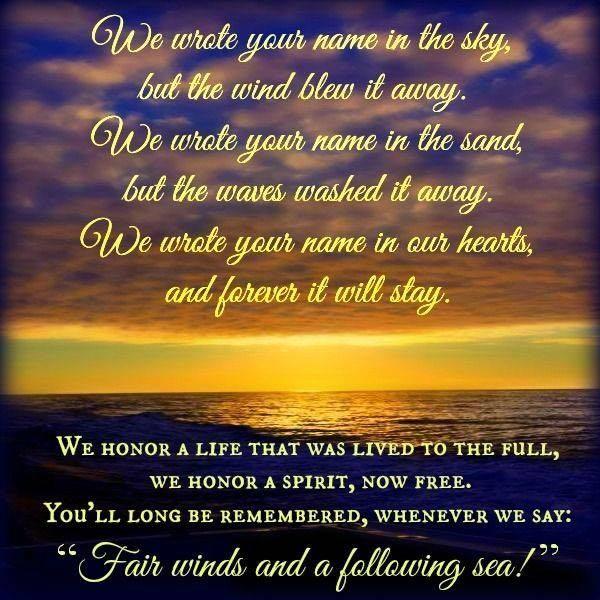


Warren HAMLYN CMDR GLEX(O)

33
The Skyhawk Years
The A-4 Skyhawk in Australian Service 1968 – 1984
Peter Greenfield and David Prest, hardback with dustjacket, full colour, 250 x 176mm, 216 pages, Avonmore Books 2023, 9780645700411 $49.95 NOW AVAILABLE
The magnificent Douglas A-4 Skyhawk served with the Royal Australian Navy from 1968 until 1984 with two squadrons: VF805 and VC724. VF805 was the frontline fighter unit that served aboard the aircraft carrier HMAS Melbourne, while VC724 was shore-based for training and support from Naval Air Station Nowra.
During that period the fixed wing aircraft on the Melbourne gave the RAN a unique capability that was central to Australian defence policy. The Skyhawk Years is a story of busy and varied deployments around Australia, Southeast Asia and regularly to the multinational Rimpac exercises in Hawaii. A particular highlight was a long cruise to the UK in 1977 and participation in the Spithead Naval Review, part of the celebrations for Her Majesty Queen Elizabeth’s Silver Jubilee.
With first-hand stories from pilots and maintainers, the challenges of operations from the world's smallest aircraft carrier are well explained. Also told are thrilling stories of air combat manoeuvres against fighters from other countries, with the A-4 often surprising more well-credentialled adversaries.
A string of mishaps ended the embarkation of Skyhawks on the Melbourne in 1980, with a sad period following which saw the ultimate scrapping of RAN fixed wing aviation four years later. However, among the former pilots and maintainers many fond memories of A-4 operations remain alive.

34
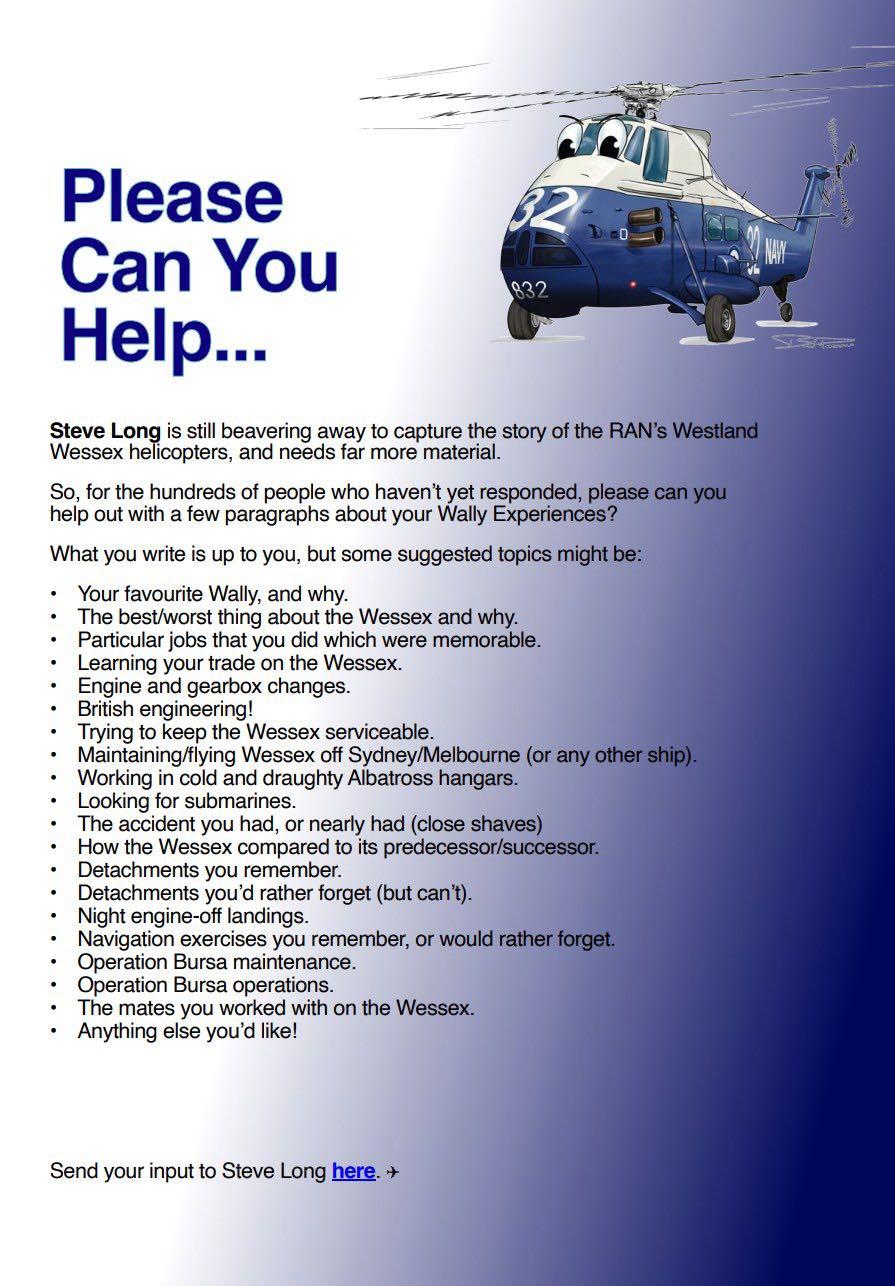
35 seavenom870@bigpond.com


36 Final clearance on caps & ladies polos $5 ea. New cap stocks coming soon with King’s Crown on FAA logo. Beat the price rise. THE NEXT ISSUE OF SLIPSTREAM WILL GO TO PRESS ON 1ST JULY 2024 CONTRIBUTIONS ARE ALWAYS WELCOME AND CAN BE SENT TO slipstream@theFAAAA.com

























































































